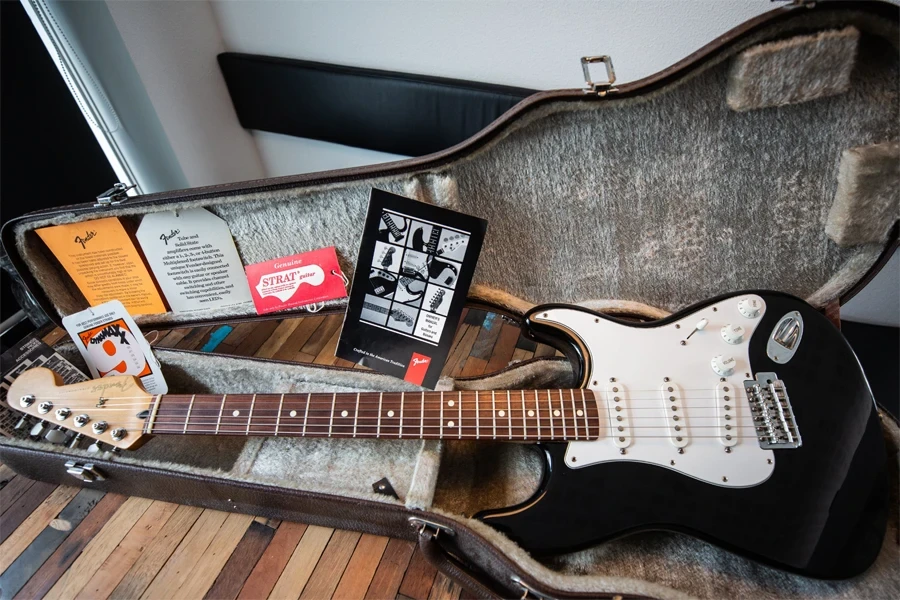In 2024, the guitar market continues to resonate with innovation and diversity, presenting a symphony of opportunities for savvy retailers worldwide. From the sleek electric axes that cater to rock enthusiasts, to the soulful acoustics that echo tradition, each guitar offers a unique narrative. This variety not only enriches the musical landscape but also opens new avenues for businesses to connect with a broader range of consumers, amplifying their market presence with every chord struck on these finely crafted instruments.
Table of Contents:
1. Strumming through the 2024 guitar market landscape
2. Fine-tuning your guitar selection strategy
3. Top guitar picks of 2024: Models and features
1. Strumming through the 2024 guitar market landscape

As 2024 unfolds, the guitar market presents a dynamic landscape shaped by evolving consumer preferences and significant market shifts. Let’s delve into the key trends and global market dynamics that are shaping this exciting industry.
Current trends and consumer preferences
The global guitar market, valued at USD 4.5 billion in 2020, is on a steady rise with an expected growth rate of 3.1% from 2021 to 2028, indicating a robust and expanding industry. Dominated by electric guitars, which make up 68% of all guitar sales, this segment continues to be the preference for a majority of consumers, leaving acoustic guitars to account for the remaining 32%. The popularization of genres like rock, blues, and country in regions like North America, where these styles hold the highest appeal, significantly influences these preferences.
A notable shift is occurring in the retail landscape of the guitar market. In 2019, online retailers captured 24% of all guitar sales, a significant portion given the traditional dominance of brick-and-mortar stores. Leading the charge in the United States were major retailers such as Guitar Center, Sam Ash, Sweetwater, and Musician’s Friend. This trend towards online purchasing reflects a broader digital transformation in retail, offering convenience and a wide array of choices for consumers.

Global market dynamics and predictions
Globally, North America remains a key player, accounting for over 40% of the market share in both the electric and overall guitar market. This region’s influence is further evidenced by its high concentration of guitar stores, exceeding 7,000 in the United States alone by 2020.
Market predictions show an optimistic trajectory for the guitar industry. By 2026, the global guitar market is projected to reach USD 5.5 billion, indicating a sustained demand and growing interest in guitar playing across various demographics. Additionally, the acoustic guitar market is expected to experience faster growth compared to electric guitars, with a predicted CAGR of 4.8% from 2021 to 2026, versus 2.4% for electric guitars.
These trends and predictions point towards a guitar market that is not only growing but also diversifying. Retailers must adapt to these changes by embracing online platforms and recognizing the shifting preferences of their customers. As the market grows, understanding these dynamics will be crucial for retailers looking to maximize their reach and capitalize on emerging opportunities in the guitar industry.
2. Fine-tuning your guitar selection strategy
In the guitar industry, choosing the right product is not just about identifying popular items; it requires a nuanced understanding of the various types of guitars, their build quality, size, playability, and budget considerations. This knowledge is crucial for online retailers to cater to the diverse needs and preferences of their customers.

Understanding different guitar types and their appeal
The guitar market offers a symphony of styles, each with its unique appeal. Electric guitars, favored for their versatility in rock, blues, and metal genres, dominate the market with a 68% share. Acoustic guitars, accounting for 32% of the market, are cherished for their rich, natural sound, appealing to fans of folk, country, and classical music. Each type attracts a different audience, and understanding these preferences is key to stocking guitars that resonate with your target market.
Evaluating build quality and materials
Build quality and materials significantly influence a guitar’s performance and longevity. The choice of wood, for instance, impacts sound quality – spruce and mahogany are popular for their resonant qualities. High-quality craftsmanship ensures durability and better sound over time, factors that customers consider when purchasing a guitar. Retailers must assess these elements to ensure they offer instruments that stand the test of time and deliver on sound expectations.
Importance of size and playability
The size and playability of a guitar are critical for customer satisfaction. A guitar that is too large or small can be uncomfortable to play, impacting a buyer’s learning and enjoyment. Retailers should offer a variety of sizes, catering to different ages and body types. Playability, determined by factors like neck shape and string height, also plays a significant role. Comfortable playability can enhance a beginner’s learning experience and a professional’s performance.
Budget considerations and price points
Lastly, budget considerations are paramount. The guitar market caters to a wide range of price points, from affordable entry-level models to high-end professional instruments. In 2020, the global guitar sales volume reached 1.7 million units, reflecting a diverse range of price points catering to various market segments. Retailers must balance quality with affordability to meet the financial constraints of their customers, offering options that provide value for money at every price level.

3. Top guitar picks of 2024: Models and features
In 2024, the guitar market showcases a variety of models, each standing out for its unique features and innovations.
Leading electric guitar models and innovations
Electric guitars continue to dominate the market, with leading brands like Fender and Gibson accounting for more than 40% of all guitar sales. The Fender Stratocaster and Gibson Les Paul models remain top picks, favored for their versatility and iconic sounds that cater to rock and blues genres. Innovations in electric guitar design focus on enhancing playability and electronic components, offering a richer sound and a more expressive playing experience.

Fender Stratocaster: A perennial favorite, this model continues to lead with its versatile three-single-coil pickup configuration, offering a bright, crisp tone ideal for blues, rock, and pop. The alder body and maple neck contribute to its lightweight design and smooth playability. The Stratocaster’s contoured body design ensures comfort during long playing sessions.
Gibson Les Paul: Known for its rich, full sound, the Les Paul features a mahogany body with a maple top, giving it a warm tone with excellent sustain. The dual humbucker pickups provide a powerful output, suitable for genres like rock and jazz. Its set-neck construction enhances sustain and resonance, making it a favorite among professional musicians.
Acoustic guitar standouts and their unique qualities

Acoustic guitars, while accounting for 32% of guitar sales, hold a special place in the market. Models from Taylor and Martin are especially renowned for their craftsmanship and sound quality. These guitars are celebrated for their rich, warm tones, making them ideal for folk, country, and classical music. Advances in acoustic guitar design have focused on improving sound projection and playing comfort, making them more appealing to a wider range of players.
Martin D-28: This classic dreadnought guitar is revered for its solid spruce top and rosewood back and sides, producing a balanced tone with excellent projection. The D-28 is known for its rich bass and articulate highs, making it a versatile choice for a variety of musical styles.
Taylor 814ce: A premium choice for discerning players, this guitar features a solid Sitka spruce top with Indian rosewood back and sides. The grand auditorium body shape offers a comfortable playing experience, while the innovative Expression System 2 electronics provide natural-sounding amplification, perfect for live performances
The rise of acoustic-electric hybrids
Acoustic-electric hybrids are gaining popularity, offering the best of both worlds. These guitars come equipped with built-in pickups and preamps, allowing for amplified play without sacrificing acoustic sound quality. This category is growing rapidly, with manufacturers focusing on improving electronic components to enhance sound fidelity.
Gibson J-45 Standard: This iconic model combines the warmth of an acoustic with the convenience of an electric. It features a solid Sitka spruce top and mahogany back and sides, delivering a rich, balanced tone. The onboard LR Baggs VTC electronics offer excellent plugged-in sound quality, maintaining the guitar’s natural acoustic resonance.
Fender Acoustasonic Telecaster: A revolutionary design blending the electric Telecaster’s shape with acoustic guitar functionality. It features a hollow body with a Sitka spruce top, allowing for both electric and acoustic playing styles. The Fender Acoustasonic’s innovative Fishman-designed Acoustic Engine provides a range of tones, from traditional acoustic to electric sounds
Specialty guitars: Classical, bass, and custom designs
Classical and bass guitars cater to niche markets but are essential to a well-rounded inventory. Classical guitars, with their nylon strings, appeal to traditionalists and fingerstyle players. Bass guitars, vital to any band setup, have seen improvements in ergonomic design and electronics. Custom guitars are also a growing segment, offering unique designs and personalized features for discerning players.
Cordoba C5 Classical Guitar: Ideal for classical and flamenco players, this guitar features a solid cedar top with mahogany back and sides. The nylon strings and wide fingerboard cater to classical playing techniques, while the lightweight build ensures player comfort.
Fender American Professional II Jazz Bass: This bass guitar stands out for its versatile sound and smooth playability. It features a solid alder body with a maple neck, offering a balanced tone. The V-Mod II single-coil Jazz Bass pickups provide a wide range of sounds suitable for various genres.
Custom Shop Guitars: For those seeking a personalized touch, custom shop guitars offer tailor-made solutions. These guitars can be built to specific requirements regarding body shapes, wood types, pickups, and aesthetics, ensuring that each instrument is as unique as its player.
Conclusion
Navigating the 2024 guitar market requires a keen understanding of evolving trends, consumer preferences, and the diverse range of available models. For online retailers, success hinges on balancing these dynamics with strategic product selection and market positioning. By staying attuned to the latest developments and customer needs, retailers can effectively cater to a broad spectrum of guitar enthusiasts, from budding musicians to seasoned professionals. In doing so, they not only contribute to the vibrant tapestry of the guitar world but also solidify their standing in a competitive and ever-evolving market.




